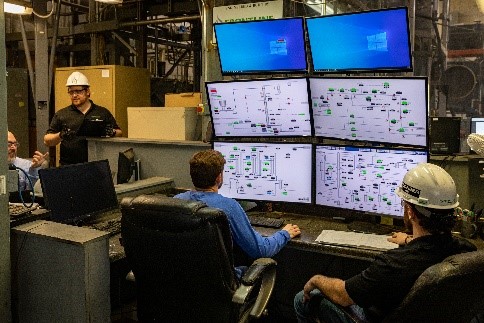Producing Ethanol for Low-Carbon Fuel Markets
May 1, 2007Frontline Starts CVEC Gasifier
April 28, 2008Syngas 101
by Jessica Ebert
Biomass Magazine, January, 2008
Interest in the thermochemical conversion of biomass into a synthesis gas that can be run through a turbine for the production of electricity, used to replace natural gas or converted into biofuel, is gaining ground. Biomass Magazine probes several experts for explanations to demystify the processes used to make syngas.
The technologies for transforming biomass into energy, fuels, chemicals or other value-added products come in one of two varieties. One is founded on the natural biological processes carried out by microbes, or they’re dependent on the calibrations of heat, pressure and/or oxygen that define various thermochemical reactions generally referred to as gasification. At the moment, the former is the glitzy star at the center of the renewable fuels stage, while the latter—the understudy to these microbial wonders—is gaining a reputation for robust consistency and efficiency.
“Syngas production is sort of an orphan,” says Alexander Koukoulas, senior technology consultant for ANL Consultants LLC, which services the pulp and paper, packaging, chemicals and bioenergy industries. “It hasn’t really seen much in the way of publicity even though it’s a much more mature technology that has been used at commercial scale for quite sometime.”
To harness the energy stored in the chemical bonds of agricultural waste, forest residues or any other of the profusion of carbohydrate-containing leftovers that can serve as renewable energy feedstocks, engineers tinker with the deforming powers of heat and pressure with the aim of breaking the linkages that hold these molecules together and capturing the chemical energy released in the process. This chemical energy is contained in a mixture of molecules collectively called synthesis gas because it’s suitable for the synthesis of various fuels and chemicals. The principal components of syngas are carbon monoxide and hydrogen but the concentrations of these and the presence of other minor molecules can be tailored by using different thermochemical reaction conditions.

The main method of producing syngas from biomass feedstocks is called gasification. Although gasification reactions can take many forms, these processes are defined by cranking up the temperature to between 650 and 1,400 degrees Celsius (1,202-2,552 Fahrenheit). There are two approaches to achieving these elevated temperatures: direct heating and indirect heating. In direct heating, a relatively small amount of oxygen is added to the reactor. If this gas is made up of more than 90 percent oxygen, the resulting syngas will be rich in carbon monoxide and hydrogen, explains Jerod Smeenk, engineering manager for Frontline BioEnergy LLC, a biomass gasifier developer and process engineering firm. A contrasting approach uses various means of indirect heat transfer to achieve high operating temperatures, including hot sand circulation and exotic alloy heat exchangers, Smeenk says. “It comes down to an economic consideration,” he says. “One must consider many factors including simplicity of design, upfront costs, operating costs, scale-up potential and the potential replacement costs for exotic alloy heat exchange components.”



